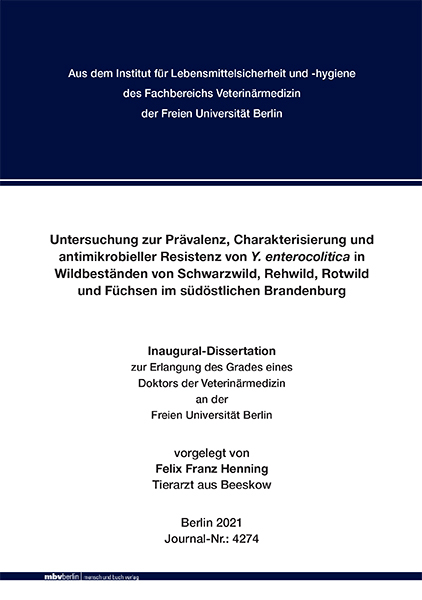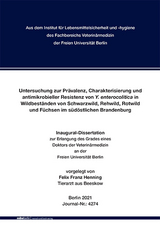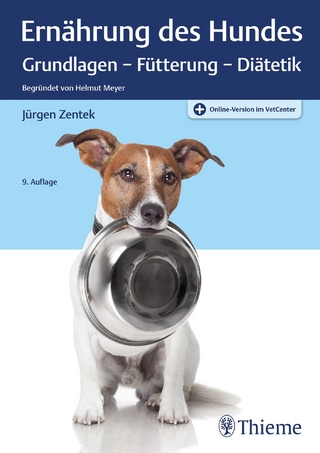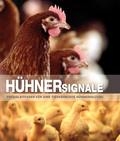Untersuchung zur Prävalenz, Charakterisierung und antimikrobieller Resistenz von Y. enterocolitica in Wildbeständen von Schwarzwild, Rehwild, Rotwild und Füchsen im südöstlichen Brandenburg
Seiten
2021
|
1. Aufl.
Mensch & Buch (Verlag)
978-3-96729-112-4 (ISBN)
Mensch & Buch (Verlag)
978-3-96729-112-4 (ISBN)
- Keine Verlagsinformationen verfügbar
- Artikel merken
Die Yersiniose, welche neben Y. pseudotuberculosis hauptsächlich durch Y. enterocolitica ausgelöst wird, tritt nach Infektionen mit Campylobacter und Salmonella als dritthäufigste bakterielle Magen-Darm-Erkrankung beim Menschen in Deutschland auf. Seit 2001 ist die Yersiniose, nach Infektionsschutzgesetz, eine meldepflichtige Erkrankung, welche vornehmlich alimentär durch den Verzehr von kontaminiertem, rohen oder unzureichend erhitztem Schweinefleisch auf den Menschen übertragen wird. Während umfangreiche Daten zu Prävalenzen in Nutztieren vorliegen, wurde das Vorkommen von Y. enterocolitica bei Wildtieren in Deutschland bisher nur wenig untersucht.
Ziel dieser Studie war, die Prävalenz von Y. enterocolitica bei unterschiedlichen Wildtierarten im südöstlichen Brandenburg zu bestimmen, die Isolate hinsichtlich ihres Bio-/Serotyps zu charakterisieren und ihre antimikrobielle Resistenz zu ermitteln.
Zu diesem Zweck wurden im Zeitraum von 2015 bis 2017 insgesamt 782 Tonsillenpaare von erlegtem Rehwild (316), Schwarzwild (310), Rotwild (110) und Füchsen (46) aus den Landkreisen Oder-Spree, Dahme-Spreewald und Spree-Neiße entnommen und im Labor untersucht. Die Proben wurden nach einer 14tägigen Kälteanreicherung in PSB auf CIN-Agar kultiviert und verdächtige Kolonien isoliert. Die Spezieszugehörigkeit wurde mittels PCR identifiziert und durch MALDI-TOF bestätigt. Weiterhin wurden die Serotypen der Stämme mittels PCR nach Garzetti et al. (2014) bestimmt und die Stämme im BfR biochemisch charakterisiert. Die antimikrobielle Resistenztestung erfolgte mittels Agardiffusionstest.
Insgesamt wurden 95 Y. enterocolitica Stämme isoliert. Die ermittelten Prävalenzen liegen beim Schwarzwild bei 21,94% (68/310), beim Rehwild bei 6,01% (19/316), beim Rotwild bei 2,73% (3/110) und bei Füchsen bei 10,87% (5/46). 12 der 95 Yersinia-Isolate trugen das ail Gen, 73 Stämme das ystB und 53 Stämme das inv Gen. Biochemisch wurden 59 Stämme dem Biotyp 1A, ein Stamm dem Biotyp 1B und ein Stamm dem Biotyp 2 zugeordnet. 34 Stämme konnten keinem Y. enterocolitica Biotypen zugeordnet werden. Am häufigsten vertreten war der Serotyp O:8 (76/95), gefolgt von O:5 (11/95) und O:3 (5/95). Drei Stämme konnten keinem Serotyp zugeordnet werden. Zwei von Wildschweinen stammende Isolate konnten den humanpathogenen Bio-/Serotypen 1B/O:8 und 2/O:8 zugeordnet werden.
Die Testung auf antimikrobielle Resistenzen ergab, dass alle Stämme gegen Kanamycin und Nalidixinsäure empfindlich sowie resistent gegen Erythromycin waren. Insgesamt betrachtet waren die meisten Y. enterocolitica-Stämme gegen die untersuchten antimikrobiellen Wirkstoffe empfindlich, aber resistent gegen Ampicillin, Erythromycin, Amoxicillin-Clavulansäure, Cefalotin und Cefazolin. Im Hinblick auf die Antibiotikaklassen zeigt sich eine verminderte Empfindlichkeit bei den Cephalosporinen der ersten Generation mit nur 2 sensiblen Stämmen gegenüber Cefalotin und 5 sensiblen Stämmen gegenüber Cefazolin. Gegen die Cephalosporine der zweiten und dritten Generation waren die untersuchten Isolate überwiegend empfindlich mit nur sechs resistenten Isolaten gegen Cefuroxim und 4 resistenten Isolaten gegen Cefotaxim. Bei den Vertretern der Penicilline zeigt sich eine gemischte Resistenzlage mit 13 sensiblen Isolaten bei Ampicillin und 29 sensiblen Isolaten bei Amoxicillin-Clavulansäure. Gegen die Gruppe der Aminoglykosidantibiotika mit Kanamycin, Gentamicin und Streptomycin waren jeweils kein, nur ein bzw. drei Isolate resistent. Gegen die Chinolone Nalidixinsäure und Ciprofloxacin waren keine bzw. fünf Isolate resistent. Gegenüber den antimikrobiellen Wirkstoffen Tetracyclin, Sulfamethoxazol/Trimethoprim, Trimethoprim und Chloramphenicol waren 92, 94, 91 und 90 Isolate empfindlich. 91 der 95 (95,8%) Isolate sind gegen drei oder mehr als drei antimikrobielle Wirkstoffe resistent.
Die vorliegende Studie deutet darauf hin, dass beim Umgang mit Wild ein Risiko besteht mit Y. enterocolitica in Kontakt zu geraten und somit eine Infektion mit Yersinia über diesen Weg möglich ist. Dies unterstreicht die Bedeutung der Einhaltung von Personal- und Wildbrethygiene im Umgang mit potentiellen Lebensmitteln zum Verbraucherschutz aber auch zum Eigenschutz. Die Personengruppen, Jäger und Fleischer, welche in der Regel den ersten und direkten Kontakt zum Tier haben, legen den Grundstein für ein hygienisches und qualitativ hochwertiges Lebensmittel. Examination of the prevalence, characterization and antimicrobacterial resistance of Y. enterocolitica in game populations of wild boars, roe deer, red deer, and foxes in southeastern Brandenburg
Yersiniosis, which is, besides Y. pseudotuberculosis, mainly caused by Y. enterocolitica, is the third leading bacterial gastrointestinal disease subsequent to infections with Campylobacter and Salmonella in Germany. Since 2001, yersiniosis is a notifiable disease according to the German Protection against Infection Act and is mainly transmitted to humans via the consumption of contaminated raw or insufficiently heated pork. While there are comprehensive data on prevalences in livestock, the presence of Y. enterocolitica in German game has not been examined in detail so far.
The objective of the present study was to determine the prevalence of Y. enterocolitica in different game species in south-eastern Brandenburg, the characterization of the isolates with regard to their bio-/serotypes, and the determination of their antimicrobial resistance patterns.
For this purpose, a total of 782 tonsil pairs of killed roe deer (316), wild boars (310), red deer (110), and foxes (46) from the districts Oder-Spree, Dahme-Spreewald, and Spree-Neiße were collected and analyzed in a laboratory. After 14 days of cold enrichment in PSB, the samples were streaked on CIN-Agar and suspect colonies were isolated. The Species of these isolates were identified via PCR and confirmed by MALDI-TOF. Serotypes of the Y. enterocolitica isolates were determined by PCR according to Garzetti et al. (2014) and the isolates were biochemically characterized in the BfR. The antimicrobial resistance patterns were analyzed by the agar diffusion method.
In total, Y. enterocolitica were isolated of 95 samples. The determined prevalences are 21.94% (68/310) in the wild boars, 6.01% (19/316) in roe deer, 2.73% (3/110) in red deer, and 10.87% (5/46) in foxes. In 12 out of the 95 Yersinia strains the ail gene, in 73 strains the ystB and in 53 strains the inv gene were detected by PCR. Biochemically, 59 strains were categorized as biotype 1A, one strain as biotype 1B, and one strain as biotype 2. For 34 strains no Y. enterocolitica biotype could be determined. Serotype O:8 was the most frequent one (76/95), followed by serotype O:5 (11/95) and O:3 (5/95). Three of the strains could not be allocated to one of the investigated serotypes. Two Y. enterocolitica strains, both isolated from wild boars, belong to the human-pathogenic bio-/serotypes 1B/O:8 and 2/O:8.
The antimicrobial resistance testing revealed that most Y. enterocolitica strains were susceptible to the antimicrobial active substances examined, but resistant to ampicillin, erythromycin, amoxicillin clavulanic acid, cefalotin, and cefazolin. All strains were susceptible to kanamycin and nalidixic acid and resistant to erythromycin. With regard to the antibiotics classes, there is a reduced susceptibility to the cephalosporins of the first generation with only two strains being susceptible to cefalotin and five strains to cefazolin. Regarding the cephalosporins of the second and third generations, most isolates were susceptible with only six isolates being resistant to cefuroxim and four isolates to cefotaxim. With the penicillins, a mixed resistance distribution could be observed: 13 isolates were susceptible to ampicillin and 29 isolates were susceptible to amoxicillin clavulanic acid. With the group of aminoglycoside antibiotics, only none, one, and three isolates were resistant to kanamycin, gentamicin, and streptomycin, respectively. Susceptible to the quinolones nalidixic acid and ciprofloxacin were none and five isolates, respectively. 92, 94, 91, and 90 isolates were susceptible to the antimicrobial active substances tetracycline, sulfamethoxazole/trimethoprim, trimethoprim, and chloramphenicol, respectively. In total, 91 out of the 95 (95.8%) isolates were resistant to three or more antimicrobial active substances.
The present study suggests that when handling game there is a risk of getting in contact with Y. enterocolitica and thus an infection with Yersinia is possible. This underlines the importance of complying with personal and game hygiene when handling potential food in order to ensure consumer protection but also self-protection. The groups of persons who usually have the initial and direct contact with the animal, i.e. hunters and butchers, lay the foundation for a hygienic and high-quality product.
Ziel dieser Studie war, die Prävalenz von Y. enterocolitica bei unterschiedlichen Wildtierarten im südöstlichen Brandenburg zu bestimmen, die Isolate hinsichtlich ihres Bio-/Serotyps zu charakterisieren und ihre antimikrobielle Resistenz zu ermitteln.
Zu diesem Zweck wurden im Zeitraum von 2015 bis 2017 insgesamt 782 Tonsillenpaare von erlegtem Rehwild (316), Schwarzwild (310), Rotwild (110) und Füchsen (46) aus den Landkreisen Oder-Spree, Dahme-Spreewald und Spree-Neiße entnommen und im Labor untersucht. Die Proben wurden nach einer 14tägigen Kälteanreicherung in PSB auf CIN-Agar kultiviert und verdächtige Kolonien isoliert. Die Spezieszugehörigkeit wurde mittels PCR identifiziert und durch MALDI-TOF bestätigt. Weiterhin wurden die Serotypen der Stämme mittels PCR nach Garzetti et al. (2014) bestimmt und die Stämme im BfR biochemisch charakterisiert. Die antimikrobielle Resistenztestung erfolgte mittels Agardiffusionstest.
Insgesamt wurden 95 Y. enterocolitica Stämme isoliert. Die ermittelten Prävalenzen liegen beim Schwarzwild bei 21,94% (68/310), beim Rehwild bei 6,01% (19/316), beim Rotwild bei 2,73% (3/110) und bei Füchsen bei 10,87% (5/46). 12 der 95 Yersinia-Isolate trugen das ail Gen, 73 Stämme das ystB und 53 Stämme das inv Gen. Biochemisch wurden 59 Stämme dem Biotyp 1A, ein Stamm dem Biotyp 1B und ein Stamm dem Biotyp 2 zugeordnet. 34 Stämme konnten keinem Y. enterocolitica Biotypen zugeordnet werden. Am häufigsten vertreten war der Serotyp O:8 (76/95), gefolgt von O:5 (11/95) und O:3 (5/95). Drei Stämme konnten keinem Serotyp zugeordnet werden. Zwei von Wildschweinen stammende Isolate konnten den humanpathogenen Bio-/Serotypen 1B/O:8 und 2/O:8 zugeordnet werden.
Die Testung auf antimikrobielle Resistenzen ergab, dass alle Stämme gegen Kanamycin und Nalidixinsäure empfindlich sowie resistent gegen Erythromycin waren. Insgesamt betrachtet waren die meisten Y. enterocolitica-Stämme gegen die untersuchten antimikrobiellen Wirkstoffe empfindlich, aber resistent gegen Ampicillin, Erythromycin, Amoxicillin-Clavulansäure, Cefalotin und Cefazolin. Im Hinblick auf die Antibiotikaklassen zeigt sich eine verminderte Empfindlichkeit bei den Cephalosporinen der ersten Generation mit nur 2 sensiblen Stämmen gegenüber Cefalotin und 5 sensiblen Stämmen gegenüber Cefazolin. Gegen die Cephalosporine der zweiten und dritten Generation waren die untersuchten Isolate überwiegend empfindlich mit nur sechs resistenten Isolaten gegen Cefuroxim und 4 resistenten Isolaten gegen Cefotaxim. Bei den Vertretern der Penicilline zeigt sich eine gemischte Resistenzlage mit 13 sensiblen Isolaten bei Ampicillin und 29 sensiblen Isolaten bei Amoxicillin-Clavulansäure. Gegen die Gruppe der Aminoglykosidantibiotika mit Kanamycin, Gentamicin und Streptomycin waren jeweils kein, nur ein bzw. drei Isolate resistent. Gegen die Chinolone Nalidixinsäure und Ciprofloxacin waren keine bzw. fünf Isolate resistent. Gegenüber den antimikrobiellen Wirkstoffen Tetracyclin, Sulfamethoxazol/Trimethoprim, Trimethoprim und Chloramphenicol waren 92, 94, 91 und 90 Isolate empfindlich. 91 der 95 (95,8%) Isolate sind gegen drei oder mehr als drei antimikrobielle Wirkstoffe resistent.
Die vorliegende Studie deutet darauf hin, dass beim Umgang mit Wild ein Risiko besteht mit Y. enterocolitica in Kontakt zu geraten und somit eine Infektion mit Yersinia über diesen Weg möglich ist. Dies unterstreicht die Bedeutung der Einhaltung von Personal- und Wildbrethygiene im Umgang mit potentiellen Lebensmitteln zum Verbraucherschutz aber auch zum Eigenschutz. Die Personengruppen, Jäger und Fleischer, welche in der Regel den ersten und direkten Kontakt zum Tier haben, legen den Grundstein für ein hygienisches und qualitativ hochwertiges Lebensmittel. Examination of the prevalence, characterization and antimicrobacterial resistance of Y. enterocolitica in game populations of wild boars, roe deer, red deer, and foxes in southeastern Brandenburg
Yersiniosis, which is, besides Y. pseudotuberculosis, mainly caused by Y. enterocolitica, is the third leading bacterial gastrointestinal disease subsequent to infections with Campylobacter and Salmonella in Germany. Since 2001, yersiniosis is a notifiable disease according to the German Protection against Infection Act and is mainly transmitted to humans via the consumption of contaminated raw or insufficiently heated pork. While there are comprehensive data on prevalences in livestock, the presence of Y. enterocolitica in German game has not been examined in detail so far.
The objective of the present study was to determine the prevalence of Y. enterocolitica in different game species in south-eastern Brandenburg, the characterization of the isolates with regard to their bio-/serotypes, and the determination of their antimicrobial resistance patterns.
For this purpose, a total of 782 tonsil pairs of killed roe deer (316), wild boars (310), red deer (110), and foxes (46) from the districts Oder-Spree, Dahme-Spreewald, and Spree-Neiße were collected and analyzed in a laboratory. After 14 days of cold enrichment in PSB, the samples were streaked on CIN-Agar and suspect colonies were isolated. The Species of these isolates were identified via PCR and confirmed by MALDI-TOF. Serotypes of the Y. enterocolitica isolates were determined by PCR according to Garzetti et al. (2014) and the isolates were biochemically characterized in the BfR. The antimicrobial resistance patterns were analyzed by the agar diffusion method.
In total, Y. enterocolitica were isolated of 95 samples. The determined prevalences are 21.94% (68/310) in the wild boars, 6.01% (19/316) in roe deer, 2.73% (3/110) in red deer, and 10.87% (5/46) in foxes. In 12 out of the 95 Yersinia strains the ail gene, in 73 strains the ystB and in 53 strains the inv gene were detected by PCR. Biochemically, 59 strains were categorized as biotype 1A, one strain as biotype 1B, and one strain as biotype 2. For 34 strains no Y. enterocolitica biotype could be determined. Serotype O:8 was the most frequent one (76/95), followed by serotype O:5 (11/95) and O:3 (5/95). Three of the strains could not be allocated to one of the investigated serotypes. Two Y. enterocolitica strains, both isolated from wild boars, belong to the human-pathogenic bio-/serotypes 1B/O:8 and 2/O:8.
The antimicrobial resistance testing revealed that most Y. enterocolitica strains were susceptible to the antimicrobial active substances examined, but resistant to ampicillin, erythromycin, amoxicillin clavulanic acid, cefalotin, and cefazolin. All strains were susceptible to kanamycin and nalidixic acid and resistant to erythromycin. With regard to the antibiotics classes, there is a reduced susceptibility to the cephalosporins of the first generation with only two strains being susceptible to cefalotin and five strains to cefazolin. Regarding the cephalosporins of the second and third generations, most isolates were susceptible with only six isolates being resistant to cefuroxim and four isolates to cefotaxim. With the penicillins, a mixed resistance distribution could be observed: 13 isolates were susceptible to ampicillin and 29 isolates were susceptible to amoxicillin clavulanic acid. With the group of aminoglycoside antibiotics, only none, one, and three isolates were resistant to kanamycin, gentamicin, and streptomycin, respectively. Susceptible to the quinolones nalidixic acid and ciprofloxacin were none and five isolates, respectively. 92, 94, 91, and 90 isolates were susceptible to the antimicrobial active substances tetracycline, sulfamethoxazole/trimethoprim, trimethoprim, and chloramphenicol, respectively. In total, 91 out of the 95 (95.8%) isolates were resistant to three or more antimicrobial active substances.
The present study suggests that when handling game there is a risk of getting in contact with Y. enterocolitica and thus an infection with Yersinia is possible. This underlines the importance of complying with personal and game hygiene when handling potential food in order to ensure consumer protection but also self-protection. The groups of persons who usually have the initial and direct contact with the animal, i.e. hunters and butchers, lay the foundation for a hygienic and high-quality product.
| Erscheinungsdatum | 23.09.2021 |
|---|---|
| Verlagsort | Berlin |
| Sprache | deutsch |
| Maße | 148 x 210 mm |
| Gewicht | 400 g |
| Themenwelt | Veterinärmedizin ► Allgemein ► Tierernährung / Tierhaltung / Tierzucht |
| Veterinärmedizin ► Klinische Fächer ► Parasitologie | |
| Schlagworte | animal tissues • Antibiotics • Antibiotika • Brandenburg • Capreolus capreolus • drug resistance • Epidemiologie • epidemiology • Foxes • Füchse • furans • Medikamentenresistenz • Prävalenz • Prevalence • Sheep • wild pigs • Wildschweine • Yersinia enterocolitica |
| ISBN-10 | 3-96729-112-X / 396729112X |
| ISBN-13 | 978-3-96729-112-4 / 9783967291124 |
| Zustand | Neuware |
| Haben Sie eine Frage zum Produkt? |
Mehr entdecken
aus dem Bereich
aus dem Bereich
Grundlagen - Fütterung - Diätetik Begründet von Helmut Meyer
Buch (2022)
Thieme (Verlag)
91,00 €
Praxisleitfaden für eine tiergerechte Hühnerhaltung
Buch | Softcover (2023)
Landwirtschaftsverlag Münster
44,80 €




